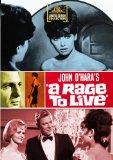| Reviews & Columns |
|
Reviews DVD TV on DVD Blu-ray 4K UHD International DVDs In Theaters Reviews by Studio Video Games Features Collector Series DVDs Easter Egg Database Interviews DVD Talk Radio Feature Articles Columns Anime Talk DVD Savant Horror DVDs The M.O.D. Squad Art House HD Talk Silent DVD
|
DVD Talk Forum |
|
|
| Resources |
|
DVD Price Search Customer Service #'s RCE Info Links |
|
Columns
|
|
|
Rage To Live (MGM Limited Edition Collection), A
Lush, husky-voiced Suzanne Pleshette as a nymphomaniac? Count me in. M-G-M's terrific M.O.D. (manufactured on demand) on-line disc service has released A Rage To Live (technically, the credits list the film as, John O'Hara's "A Rage to Live", a 1965 super-sudser from United Artists, based on the 1949 best-selling pot boiler from O'Hara, and starring Pleshette, Bradford Dillman, Ben Gazzara, and Peter Graves. A potentially intriguing look at a woman's psycho-sexual obsessions, A Rage To Live can't quite overcome its still-landlocked Hollywood studio treatment (no nudity or frank sexual depictions, as would have been the case just a few years later), but as a big-screen soaper, it hits all the marks fans of this genre expect, with a beautiful black and white transfer here a big bonus.
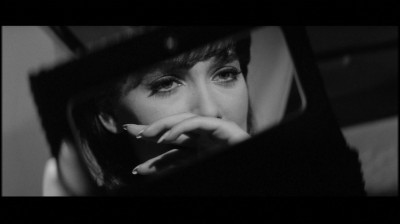
Staid Fort Penn, Pennsylvania. High school student and underage minor Grace Caldwell (Suzanne Pleshette), of Fort Penn's most wealthy, influential family, walks home to her mansion, and to the accompaniment of some dirty sax music, strips down for a shower (this is getting good....). Little does she know as she stands in impressive silhouette that Charlie Jay (Mark Goddard), the lunk-headed friend of Grace's brother, Brock Caldwell (Linden Chiles), is watching her, waiting. Not satisfied with her good-natured put-downs to leave, Brock forces himself on Grace, but only at first; his assault awakens in Grace a powerful sexual response that she embraces. Continuing her sexual relationship with Charlie (along with other boys, as well), she's eventually caught, but the scandal is contained by her mother, Emily (Carmen Mathews), as well as her concerned brother Brock, who's worried Grace will turn into a tramp. Grace, however, says what she feels for a man when he makes love to her isn't "settling." It's "almost love," and she's powerless to deny it. After promising to "be good," for her brother, Grace meets quiet, morally upright future farmer of America Sidney Tate (Bradford Dillman), who defends Grace's honor when Charlie Jay gets mouthy in a restaurant. Grace likes that...but she also likes seeing former tennis pro Jack Hollister (Peter Graves), whose new wife, Amy (Bethel Leslie), knows a tramp threat when she sees one. Marriage to Sidney seems like a good dampener for Grace's "central problem," as her family doctor (James Gregory) puts it...but she doesn't count on the sweaty, manly charms of aspiring engineer Roger Bannon (Ben Gazzara), who has been keeping his eye on Grace for years.
MAJOR PLOT SPOILERS WARNING!
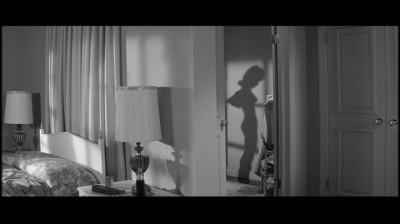
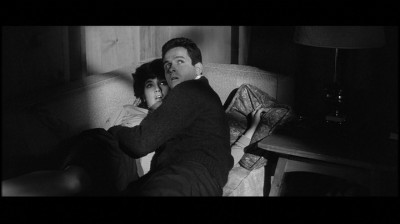
This isn't a review of author John O'Hara's work (I think he's vastly underrated by today's critics), but one can make the case that his frequent themes about social climbing and his once-frank discussions of human sexuality, were the perfect fodder for other screenwriters to fashion superior "soap opera mellers" (and I don't use that term as a pejorative, as readers of my other reviews will know). Movies like BUtterfield 8, Ten North Frederick, and From the Terrace certainly have their detractors, but I find they satisfy a primary desire of American audiences to observe―and vicariously enjoy―the sufferings of the very rich and those who aspire to "higher" social classes, particularly if that pretty, pretty suffering comes with romantic complications and sexual hijinks in the mix. And A Rage To Live is certainly no different.
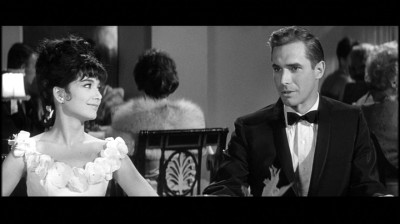
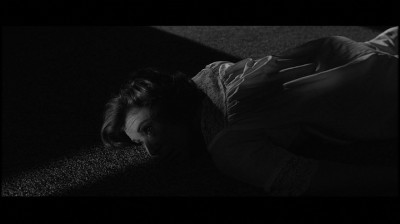
One could probably write a good term paper for, um...film school (yeech) by comparing the levels of frankness reached in a mainstream Hollywood production like A Rage To Live compared to something like Darling, which was released the same year to universal acclaim. Had A Rage To Live been produced just a few years later, when Hollywood films finally shrugged off the very last vestiges of the Production Code, no doubt the depiction of Grace's nymphomania would have been more graphic. As it is, it looks far more tame and linear compared to England's Darling, not just in what is shown on the screen, but also in how far it delves into the psychology of the main character. I haven't read A Rage To Live since college, so I can't remember how much of what I'm hearing in this movie adaptation comes from O'Hara or screenwriter John T. Kelley (Alfred Hitchcock Presents, The Millionaire, Zigzag). However, it's certainly clear that director Walter Grauman (one of television's best directors, having done superlative work in series like Route 66 and particularly The Fugitive) isn't striving to illustrate a case work on nymphomania. We're given one or two intriguing glimpses into Grace's reasons for wanting sex with as many men as possible (her speech to her brother about "almost love" was still fairly daring, I would imagine, for some 1965 American audiences). However, A Rage To Live is far more interested in storytelling, in moving the plot along from situation to situation, creating the visual equivalent of a "page turner" as we continually try to decide if we sympathize or not with Grace's situation.

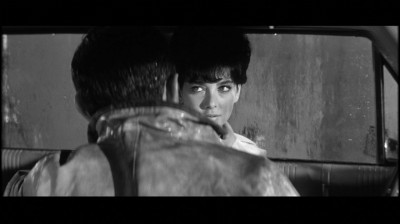
You can find sociological, psychological, and even political messages in any movie if you look hard enough―even in films that aggressively strive not to have such subtexts. And I suppose the issue that would interest anyone today looking at A Rage To Live is the depiction of Grace's guilt over her uncontrollable urges, versus the film's sometimes morally even-handed depiction of her actions. Right from the start, the movie wants us to give Grace a "break," showing her plausibly argue that she was only "necking" with Charlie (did she "go all the way," we wonder...which only increases our pleasurably puerile titillation level), while putting forth that it's those who judge her, like Charlie's mother, Brett Somers, who have the dirty minds. The movie is quite good at walking this uneasy tightrope, showing Grace crying one moment after making out with a boy in his car, to her rationally explaining to her brother that not only can't she help her urges...but that she's not "settling" for a lesser life by indulging in them. A Rage To Live has no trouble showing Grace destroyed by the death of her mother, who drops dead calling for Grace's help as Grace enjoys a sexual liaison with a hotel waiter (Grauman delivers a memorably ghastly image of Mathews' staring, dead eyes caught in the hallway light as Grace discovers her body), while also letting us vicariously enjoy her "wrong" relationship with Roger―which seems like sweaty, dirty fun, at least at first.
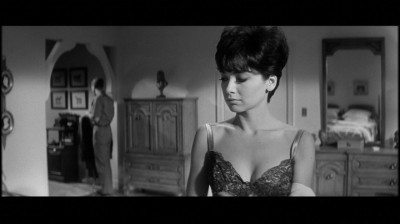
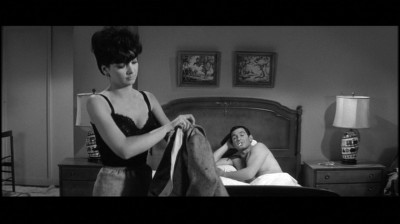
This morally teasing approach comes about because A Rage To Live is most interested in telling a compelling story. For decades now, the power of "simple storytelling" has been derided in favor of ambiguous character examinations in American films (hence the cliched bias towards European "art" films among a lot of critics, if one can generalize outrageously), but there are primal pleasures to be found in watching a set of characters moved through an interesting set of obstacles where the emphasis is more on the movement rather than on the "why" of the movement. Yes, A Rage To Live takes a swipe at explaining Grace's actions, but it's more interested in those actions themselves―hence, the pleasurably "soapy" aspects of the film. There's no denying the fact that the movie's strongest appeal comes from our anticipation of Grace's continual dalliances, and with sultry-eyed, lush Suzanne Pleshette's husky voice and inescapably erotic demeanor informing her scenes with carnal suspense, why shouldn't we find pleasure in that emphasis by the filmmakers―particularly when Pleshette is so good at her job here?
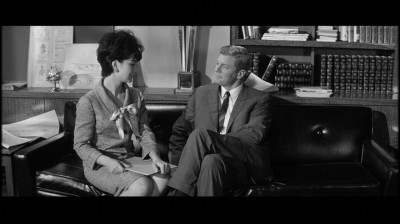
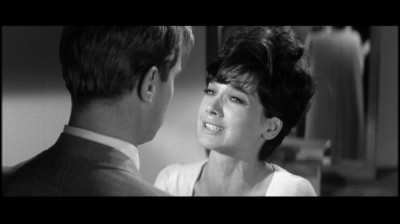
Yes, the filmmakers largely blow O'Hara's subtext of the social climbing aspects of both Dillman's and Gazarra's characters, but they more than make up for that lack by keeping the camera on Pleshette, in various fetching outfits and lingerie, as her smoky eyes register guilt, lust, and always a knowing foreshadowing of her coming downfall. Would I have preferred different male leads in the picture? Probably. Dillman is well-cast as the too-good, too-bland farmer whose denatured sexuality can't hold Pleshette's raging impulses in check. However, Gazarra's a turn-off right from the first scene, alternately angry and bored, rather than playful and sexy (one wonders if he thought he was "slumming" here), while Graves is hilariously asexual as a potential third partner. But again, their lack of impact doesn't necessarily detract from the film's pleasures; their characters fill their expected genre roles (nice but weak husband, sexy, dangerous stranger, unrequited love from the past), and they're moved in and out of the plot (and through cinematographer Charles Lawton's creamy, beautiful black and white frames) with ease by Kelley and Grauman. As with any good story, we want to know what happens next, and A Rage To Live keeps us "turning the pages," wondering not if, but when, Grace will ultimately fall from grace, with Grauman conjuring up a suitably ambiguous final image: a weeping Grace, on the apex of a foot bridge, as her husband leaves her. We're not compelled by the psychology of the moment, or the internals ticks of her characterization―we want to know if she'll get him back, if she'll "cross over," if you will. Or will she fall back into her nymphomania (I know which one I'm voting for...). That's good storytelling. And that's valid in its own right.
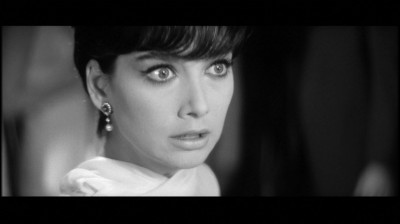

The DVD:
The Video:
The wide, wide 2.35:1 anamorphically-enhanced black and white transfer for A Rage To Live looks sensational, with a delicately valued gray scale, solid blacks, and a razor-sharp image.
The Audio:
The Dolby Digital English mono audio track is solid, with hum barely noticeable and a re-recording level that's consistent. No subtitles or close-captions available, however.
The Extras:
No extras this time for A Rage To Live.
Final Thoughts:
Story over psychology. Anyone expecting a "serious" discussion of nymphomania should look elsewhere than A Rage To Live. This gorgeous-looking 1965 pot boiler is more interested in putting beautiful people in suitably titillating, compromising positions so we the audience can enjoy it all from afar―and that's how we like our soap operas. It helps, too, that Suzanne Pleshette is not only gorgeous, but also that she gives one of her best performances here. I recommend A Rage To Live.
Paul Mavis is an internationally published film and television historian, a member of the Online Film Critics Society, and the author of The Espionage Filmography.


|
| Popular Reviews |
| Sponsored Links |
|
|
| Sponsored Links |
|
|
| Release List | Reviews | Shop | Newsletter | Forum | DVD Giveaways | Blu-Ray | Advertise |
|
Copyright 2024 DVDTalk.com All Rights Reserved. Legal Info, Privacy Policy, Terms of Use,
Manage Preferences,
Your Privacy Choices | |||||||









